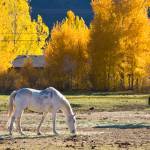Watch Horse Pastures for Tree Leaves and Branches

Many horses will taste-test tree leaves from time to time, and in most instances, this snack isn’t dangerous. However, leaves from some trees contain toxins that can make horses seriously ill. Depending on the type of tree, fresh, wilted, or dry leaves can be risky if horses eat even small quantities.
Toxins from red maple leaves cause destruction of red blood cells, limiting the blood’s ability to transport oxygen throughout the horse’s body. Oak leaves trigger kidney damage as well as gastrointestinal problems like colic and bloody diarrhea. Leaves from cherry, peach, almond, plum, and apricot trees contain cyanide compounds, and walnut tree leaves and other parts affect the horse’s heart and respiratory rates and often lead to severe laminitis.
Wilting concentrates toxins in some leaves to a dangerous or even fatal level. When severe spring and summer storms blow broken limbs into pastures and horses munch on the foliage, it doesn’t take more than a few ounces of the leaves from certain trees to bring on signs of poisoning.
Small trees and shrubs used for ornamental landscaping can also be dangerous if they are ingested by horses. These include yew, oleander, rhododendron, and mountain laurel, among others. Trimmings from these plants should never be disposed of in pastures or any areas to which horses have access.
It may not be practical for property owners to remove trees from turnout areas and fencerows, but anyone pasturing horses near trees that are known to have toxic foliage should be on the lookout for branches and leaves on the ground, especially after high winds and severe storms. Hay should also be checked for the presence of leaves. Horse owners can consult a local agricultural extension agent or staff member from a landscaping service to identify trees that may be dangerous to horses.








